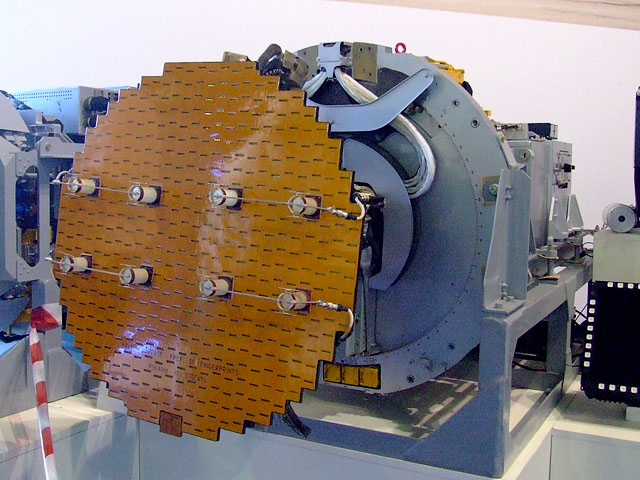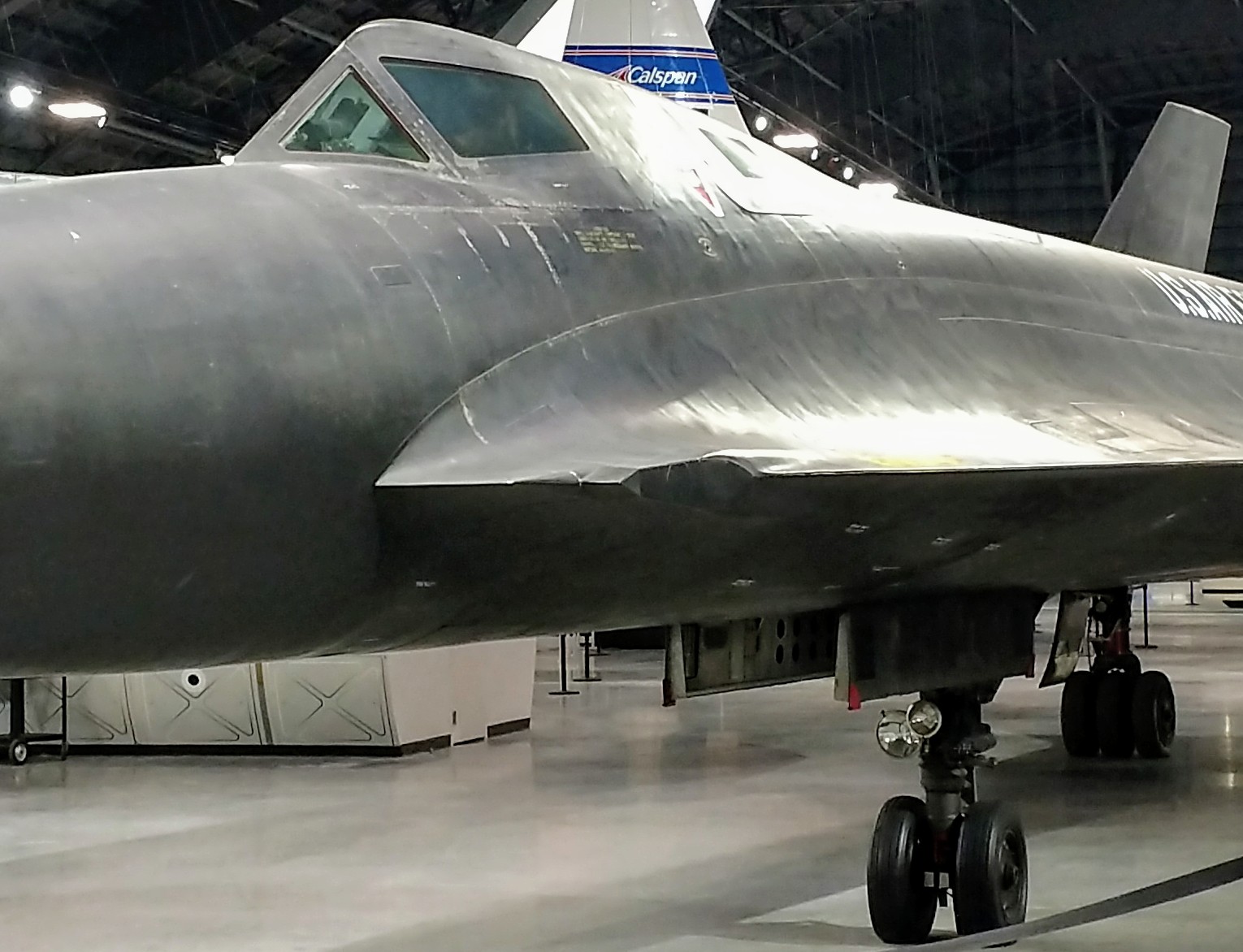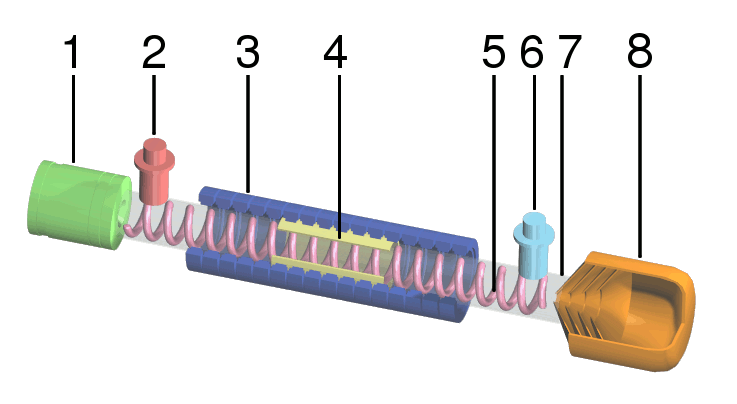|
Pulse-Doppler Radar
A pulse-Doppler radar is a radar system that determines the range to a target using pulse-timing techniques, and uses the Doppler effect of the returned signal to determine the target object's velocity. It combines the features of pulse radars and continuous-wave radars, which were formerly separate due to the complexity of the electronics. The first operational pulse-Doppler radar was in the CIM-10 Bomarc, an American long range supersonic missile powered by ramjet engines, and which was armed with a W40 nuclear weapon to destroy entire formations of attacking enemy aircraft. Pulse-Doppler systems were first widely used on fighter aircraft starting in the 1960s. Earlier radars had used pulse-timing in order to determine range and the angle of the antenna (or similar means) to determine the bearing. However, this only worked when the radar antenna was not pointed down; in that case the reflection off the ground overwhelmed any returns from other objects. As the ground moves at th ... [...More Info...] [...Related Items...] OR: [Wikipedia] [Google] [Baidu] |
Moving Target Indicator
Moving target indication (MTI) is a mode of operation of a radar to discriminate a target against the clutter. It describes a variety of techniques used for finding moving objects, like an aircraft, and filter out unmoving ones, like hills or trees. It contrasts with the modern stationary target indication (STI) technique, which uses details of the signal to directly determine the mechanical properties of the reflecting objects and thereby find targets whether they are moving or not. Early MTI systems generally used an acoustic delay line to store a single pulse of the received signal for exactly the time between broadcasts (the pulse repetition frequency). This stored pulse will be sent to the display along with the next received pulse. The result was that the signal from any objects that did not move mixed with the stored signal and became muted out. Only signals that changed, because they moved, remained on the display. These were subject to a wide variety of noise effects th ... [...More Info...] [...Related Items...] OR: [Wikipedia] [Google] [Baidu] |
Doppler Effect Diagrammatic
The Doppler effect (also Doppler shift) is the change in the frequency of a wave in relation to an observer who is moving relative to the source of the wave. The ''Doppler effect'' is named after the physicist Christian Doppler, who described the phenomenon in 1842. A common example of Doppler shift is the change of pitch (music), pitch heard when a vehicle sounding a horn approaches and recedes from an observer. Compared to the emitted frequency, the received frequency is higher during the approach, identical at the instant of passing by, and lower during the recession. When the source of the sound wave is moving towards the observer, each successive cycle of the wave is emitted from a position closer to the observer than the previous cycle. Hence, from the observer's perspective, the time between cycles is reduced, meaning the frequency is increased. Conversely, if the source of the sound wave is moving away from the observer, each cycle of the wave is emitted from a position ... [...More Info...] [...Related Items...] OR: [Wikipedia] [Google] [Baidu] |
Speed Of Light
The speed of light in vacuum, commonly denoted , is a universal physical constant exactly equal to ). It is exact because, by international agreement, a metre is defined as the length of the path travelled by light in vacuum during a time interval of second. The speed of light is invariant (physics), the same for all observers, no matter their relative velocity. It is the upper limit for the speed at which Information#Physics_and_determinacy, information, matter, or energy can travel through Space#Relativity, space. All forms of electromagnetic radiation, including visible light, travel at the speed of light. For many practical purposes, light and other electromagnetic waves will appear to propagate instantaneously, but for long distances and sensitive measurements, their finite speed has noticeable effects. Much starlight viewed on Earth is from the distant past, allowing humans to study the history of the universe by viewing distant objects. When Data communication, comm ... [...More Info...] [...Related Items...] OR: [Wikipedia] [Google] [Baidu] |
Lockheed YF-12
The Lockheed YF-12 is an American Mach number, Mach 3+ capable, high-altitude interceptor aircraft, interceptor prototype, developed and manufactured by American aerospace company Lockheed Corporation. The interceptor was developed during the late 1950s and early 1960s as a potential replacement for the F-106 Delta Dart interceptor for the United States Air Force (USAF). The YF-12 was a twin-seat version of the then-secret single-seat Lockheed A-12 reconnaissance aircraft operated by the Central Intelligence Agency (CIA); unlike the A-12, it was furnished with the Hughes AN/ASG-18 fire-control radar and could be armed with AIM-47 Falcon (GAR-9) air-to-air missiles. Its maiden flight was on 7 August 1963. Its existence was publicly revealed by President Lyndon B. Johnson on 24 February 1964; this move was to provide plausible deniability for the CIA-operated A-12 fleet, which closely resembled the prototype YF-12. During the 1960s, the YF-12 underwent flight evaluations b ... [...More Info...] [...Related Items...] OR: [Wikipedia] [Google] [Baidu] |
North American XF-108 Rapier
The North American XF-108 Rapier was a proposed long-range, high-speed interceptor aircraft designed by North American Aviation intended to defend the United States from supersonic Soviet Union, Soviet strategic bombers. The aircraft would have cruised at speeds around with an unrefueled combat radius over , and was equipped with radar and missiles offering engagement ranges up to against bomber-sized targets. To limit development costs, the program shared engine development with the North American XB-70 Valkyrie strategic bomber program, and used a number of elements of earlier interceptor projects. The program had progressed only as far as the construction of a single wooden mockup when it was canceled in 1959, due to a shortage of funds and the Soviets' adoption of ballistic missiles as their primary means of nuclear attack. Had it flown, the F-108 would have been the heaviest fighter of its era. Prior to the project's cancellation, U.S. President Dwight D. Eisenhower not ... [...More Info...] [...Related Items...] OR: [Wikipedia] [Google] [Baidu] |
Hughes AN/ASG-18 Fire Control System
The AN/ASG-18 Fire Control System produced by Hughes Aircraft was a prototype airborne fire control radar system for the planned North American XF-108 Rapier interceptor aircraft, and the Lockheed YF-12 for the United States Air Force. It was the US's first Pulse-Doppler radar, giving it look-down/shoot-down capability, and was also the first track while scan radar (could track one target at a time). This was paired with an infrared search and track (IRST) system. Range of the radar was estimated at between , with reliable detection of bomber-sized targets at . The installation itself was massive, weighing , and taking up most of the nose of the aircraft. The system was to be used with the Hughes AIM-47 Falcon missile, which also had a range of about 100 miles. While development work was done with the XF-108, the AN/ASG-18 and Falcon missiles were first tested on a highly modified Convair B-58 Hustler bomber. To fit the radar, the nose was lengthened nearly , and the infrared sens ... [...More Info...] [...Related Items...] OR: [Wikipedia] [Google] [Baidu] |
AN/SPG-51
The AN/SPG-51 is an American tracking / illumination fire-control radar for RIM-24 Tartar and RIM-66 Standard missiles. It is used for target tracking and Surface-to-air missile guidance as part of the Mk. 73 gun and missile director system, which is part of the Tartar Guided Missile Fire Control System. Aircraft tracking is based on monopulse radar utilizing Pulse-Doppler radar signal processing in MK 74 MOD 14 and MK 74 MOD 15. The MK 74 MOD 15 configuration includes continuous-wave radar tracking in addition to pulse-Doppler tracking. It provides illumination for bistatic radar operation associated with missile guidance in all configurations. Older systems rely on conical scanning rather than monopulse. In accordance with the Joint Electronics Type Designation System (JETDS), the "''AN/SPG-51''" designation represents the 51st design of an Army-Navy electronic device for waterborne fire control radar equipment. The JETDS system also now is used to name all Department of Defense ... [...More Info...] [...Related Items...] OR: [Wikipedia] [Google] [Baidu] |
Coherence (physics)
Coherence expresses the potential for two waves to Wave interference, interfere. Two Monochromatic radiation, monochromatic beams from a single source always interfere. Wave sources are not strictly monochromatic: they may be ''partly coherent''. When interfering, two waves add together to create a wave of greater amplitude than either one (constructive Wave interference, interference) or subtract from each other to create a wave of minima which may be zero (destructive interference), depending on their relative phase (waves), phase. Constructive or destructive interference are limit cases, and two waves always interfere, even if the result of the addition is complicated or not remarkable. Two waves with constant relative phase will be coherent. The amount of coherence can readily be measured by the interference visibility, which looks at the size of the interference fringes relative to the input waves (as the phase offset is varied); a precise mathematical definition of the de ... [...More Info...] [...Related Items...] OR: [Wikipedia] [Google] [Baidu] |
Traveling Wave Tube
A traveling-wave tube (TWT, pronounced "twit") or traveling-wave tube amplifier (TWTA, pronounced "tweeta") is a specialized vacuum tube that is used in electronics to amplify radio frequency (RF) signals in the microwave range. It was invented by Andrei Haeff around 1933 as a graduate student at Caltech, and its present form was invented by Rudolf Kompfner in 1942–43. The TWT belongs to a category of "linear beam" tubes, such as the klystron, in which the radio wave is amplified by absorbing power from a beam of electrons as it passes down the tube. Although there are various types of TWT, two major categories are: *''Helix TWT'' - in which the radio waves interact with the electron beam while traveling down a wire helix which surrounds the beam. These have wide bandwidth, but output power is limited to a few hundred watts. *''Coupled cavity TWT'' - in which the radio wave interacts with the beam in a series of cavity resonators through which the beam passes. These functio ... [...More Info...] [...Related Items...] OR: [Wikipedia] [Google] [Baidu] |





